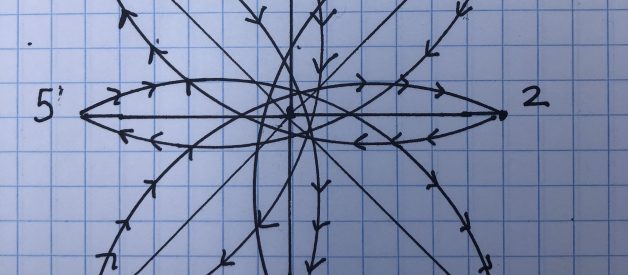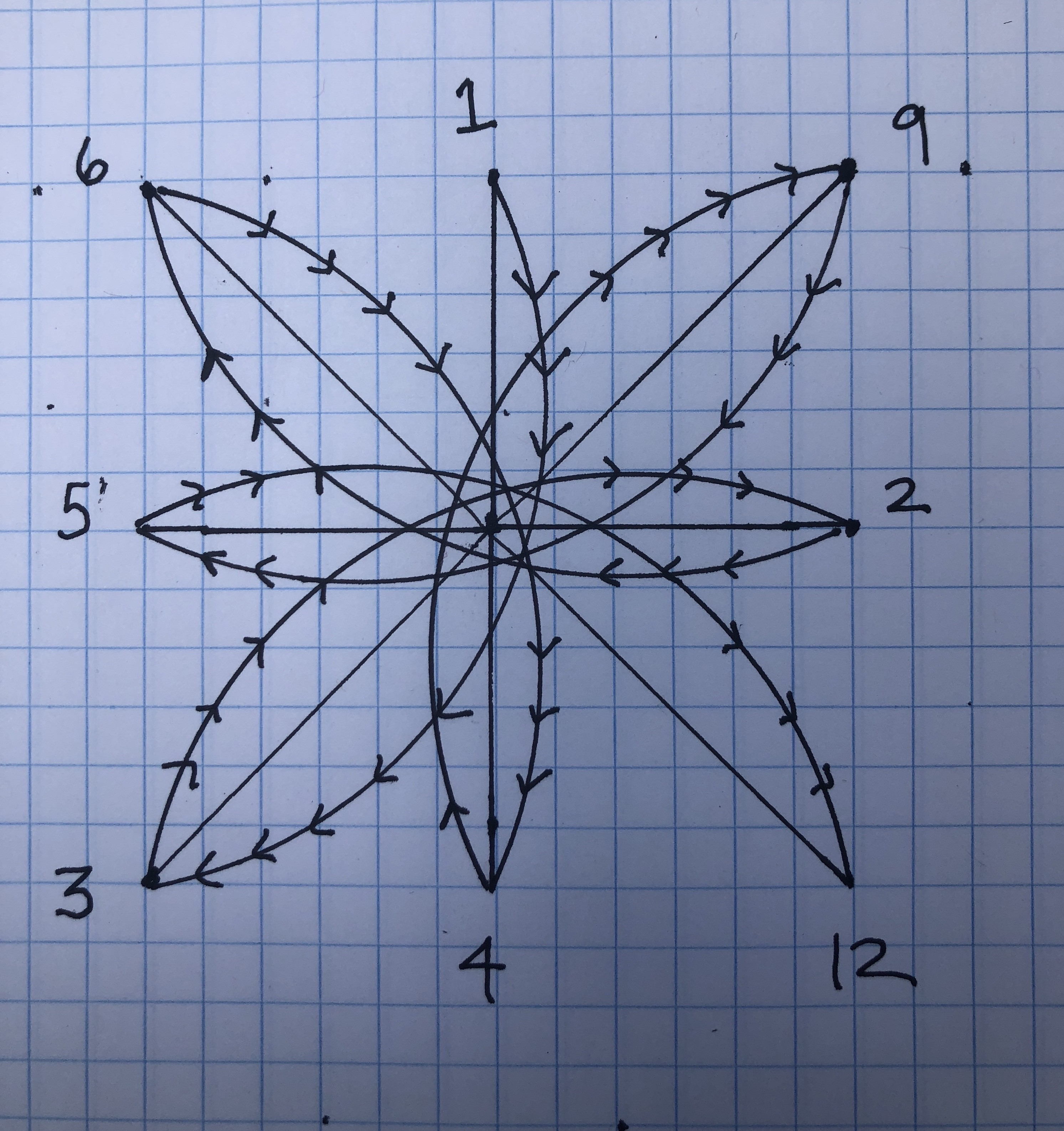
There is no known formula for easily calculating prime numbers. Their distribution along the continuum of numbers appears to be random. There are, however, formulas and diophantine equations that will calculate prime numbers. There are algorithms that can calculate primes into the millions of digits. But these prime-finding algorithms require a great deal of time and math to accomplish their task.
I humbly submit that I?ve discovered a super-easy way to find and count prime numbers.
I don?t know what this equation means for math, or number theory; I don?t know if it will help solve the Riemann hypothesis, or if it works with the zeta function. I?m no mathematician. I just know that it?s a simple two-step equation that works to reliably reveal prime numbers. And it?s kinda fun.
If you start with the number 2 and then you plug in each next integer (3, 4, 5, 6, 7, 8?) into the equation, you can count your way up the continuum of prime numbers. Never missing one. In fact, it?s so easy that an 8-year-old with basic multiplication skills could find prime numbers with digits into the thousands and tens of thousands using just their smartphone calculator.
I?m fairly certain that one could write a computer program using this equation that would find all of the prime numbers as high as you care to calculate.
Prime numbers seem to be arranged in overlapping wave patterns. They rise and fall in these predictable rhythms. From what I can tell, there are 5 waves of prime numbers. Each rises and falls on its own simple count and rhythm. Ultimately, they braid together to form the continuum of prime numbers, the one that appears random, but once you spot its pattern in the number sets, the distribution of prime numbers begins to look more like this:

To calculate prime numbers, all you need to do is pick an integer. Any integer.
Then you perform one simple act of sorting.
Look at the last digit in the number you selected.
Is it even, or is it odd? Does it end in 0, or a 5? Or does it end in a 2?
Those are the five waves.
There are even numbers: 4, 6, 8.
There are the odd numbers: 3, 7, 9
There are the numbers that end in 5s or 0s.
And there are numbers that end in 2.
Each set of numbers has its own wave. Or one might call it their frequency.
Just look to the last digit of *any integer* and then plug the integer into the corresponding equation:
If the integer ends in an even number (4, 6, 8), the equation is: 3(n) ? 1
(multiply the integer by 3, then subtract 1)
If the integer ends in an odd number (3, 7, 9), the equation is: 3(n) ? 10
(multiply the integer by 3, subtract 10)
If the integer ends in a 2, the equation is: 3(n) +1
(multiply the integer by 3, then add 1)
Integers that end in 0s and 5s, are different. They often divide into twin primes. Those are two prime numbers located on either side of a non-prime integer. For instance, 71 and 73; or 1697 and 1699. Integers ending in 0s and 5s, sometimes, but not always, calculate out as twin primes.
To find them, here are two solutions:
If the integer ends in a 5, the equation is: 3(n) -2 and 3(n) +2
If the integer ends in a 0, the equation is: 3(n) -1 and 3(n) +1
So, there you go. Pick a number. If the last digit is:
-even: 3(n) -1
-odd: 3(n) -10
-2s: 3(n) +1
-5s: 3(n) -2 and 3(n) +2
-0s: 3(n) -1 and 3(n) +1
Here?s a list to check your prime numbers.
And here are some examples to get you started:
4 is an even number: (3 x 4) -1= 11
13 is an odd number: (3 x 13)-10 = 29
42 ends in a 2: (3 x 42) +1 = 127
35 ends in a 5: (3 x 35)-2 = 103 and (3 x 35) +2= 107
1998 is an even number: (3 x 1998) -1 = 5993
83 is an odd number: (3 x 83) -10= 239
2002 ends in 2: (3 x 2002) +1= 6007
715 ends in 5: (3 x 715) -2= 2147 and (3 x 715) +2= 2143
1,840 ends in 0: (3 x 1840) -1= 5,519 and (3 x 1840) +1= 5,521
With the twin primes numbers (created by integers ending in 0s or 5s), from what I?ve found, the resulting products of this prime wave equation won?t always be prime numbers. In fact, sometimes neither product is a prime number. Not all numbers ending in 0, or 5, have a relative prime number. As the gap between the 0s and 5s of the prime wave patterns grows wider the multiples of seven and eleven overlap to fill in the gaps.
For instance, 3,810 ends in 0:
(3 x 3810) -1= 11,429 (isn?t a prime number, it?s divisible by 11 x 1039)
(3 x 3810) +1= 11,431 (isn?t a prime number, it?s divisible by 7 x 1633)
This is where the deviation of the prime number pattern becomes evident. The higher you climb up the number line the fewer prime numbers there are. As the gaps between prime numbers begin to grow, the pattern repeats but with less frequency. Numbers that end in zero often calculate out to be a non-prime numbers, typically divisible by 7 or 11. (There seems to be a pattern here, too.)
I discovered this prime number wave equation purely by accident.
I was looking for something else. I wanted to create a mathematical sequence that rhythmically, periodically increased in value by multiplication, as it oscillated in value by subtraction, at the same time. I wanted to do math that had a sense of time inherent in it. Math with a past, present, and future implied. I wanted math that would swing, but steady like a pendulum.
So I created this pendulum sequence:
(n0) = 0 and (n1)= 1. Those are your starting points.
Then you start it swinging with: (n2)= 3.
Now subtract the difference of 3 -1. The answer is (n3)= 2.
Then (n4)= 6.
Subtract the difference of 6?2. The answer is (n5)= 4.
It follows that (n6) = 9.
Subtract the difference of 9?4. The answer is (n7)= 5.
This pattern repeats?until you run out of numbers to count.
In more formulaic terms, the pendulum sequence can be generated:
(n0) = 0 and (n1) = 1
(n2) = 3
(n3) = (n2 ? n1)
(n4) = 6
(n5) = (n4 ? n3)
(n6) = 9
(n7) = (n6? n5)
(n8) = 12
(n9) = (n8 ? n7)
(?pattern repeats, approaching infinity.)
As you count up the number line, here are the first few lines of the sequence:
1, 3, 2, 6, 4, 9, 5, 12,
7, 15, 8, 18, 10, 21, 11, 24,
13, 27, 14, 30, 16, 33, 17, 36
19, 39, 20, 42, 22, 45, 23, 48
25, 51, 26, 54, 28, 57, 29, 60
31, 63, 32, 66, 34, 69, 35, 72
37, 75, 38, 78, 40, 81, 41, 84
43, 87, 44, 90, 46, 93, 47, 96
Do you notice anything about the numbers? Do you see any clear patterns in the columns and rows? If you go row by row, you?ll notice that each column either counts up by 6, or up by 12.
There?s also another evident pattern. If you exclude the first primes: (3) and (2), you?ll notice there are two columns that almost exclusively count prime numbers. In fact, those columns are the only two places that prime numbers show up in the pattern of this pendulum sequence.
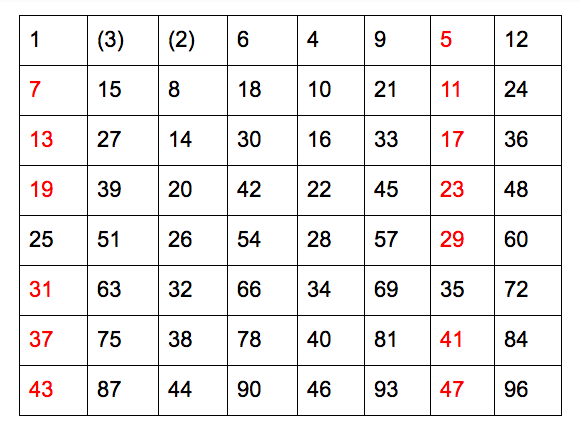 a table of the first 8 rows of the prime wave sequence
a table of the first 8 rows of the prime wave sequence
This is how I discovered the pattern of prime number propagation.
Once I noticed this pattern, I reverse-engineered what was happening in the sequence. And that?s how I arrived at five distinctive patterns, or waves, of prime numbers.
There?s one wave of prime numbers for integers that end in even numbers (4, 6, 8), there?s another one for integers that end in odd numbers (3, 7, 9), there?s another wave for numbers ending in 2s, and there?s the twin prime patterns for integers that end with a 5, or in a 0.
To calculate my pendulum sequence, and to keep track of specific sets of the sequence, I created a visual calculator. It?s a simple design.
Here?s how you create one.
Draw an X. Then draw the vertical and horizontal lines that cross the X. Essentially, it?s a compass rose, denoting north, south, east, west and their inter-cardinal directions such as southwest.
Start at the top point, the north, and draw a number one.
Next, draw a curve, descending to the lower left, to southwest. Once there, draw a 3.
So it looks like this?

Next, inscribe a curve across to the mid-point on the right side, the east, and draw a 2.
Then, track back across to the upper left, northwest, and draw a 6.
Then curve down to the south, the center point at the bottom. That?s your 4.
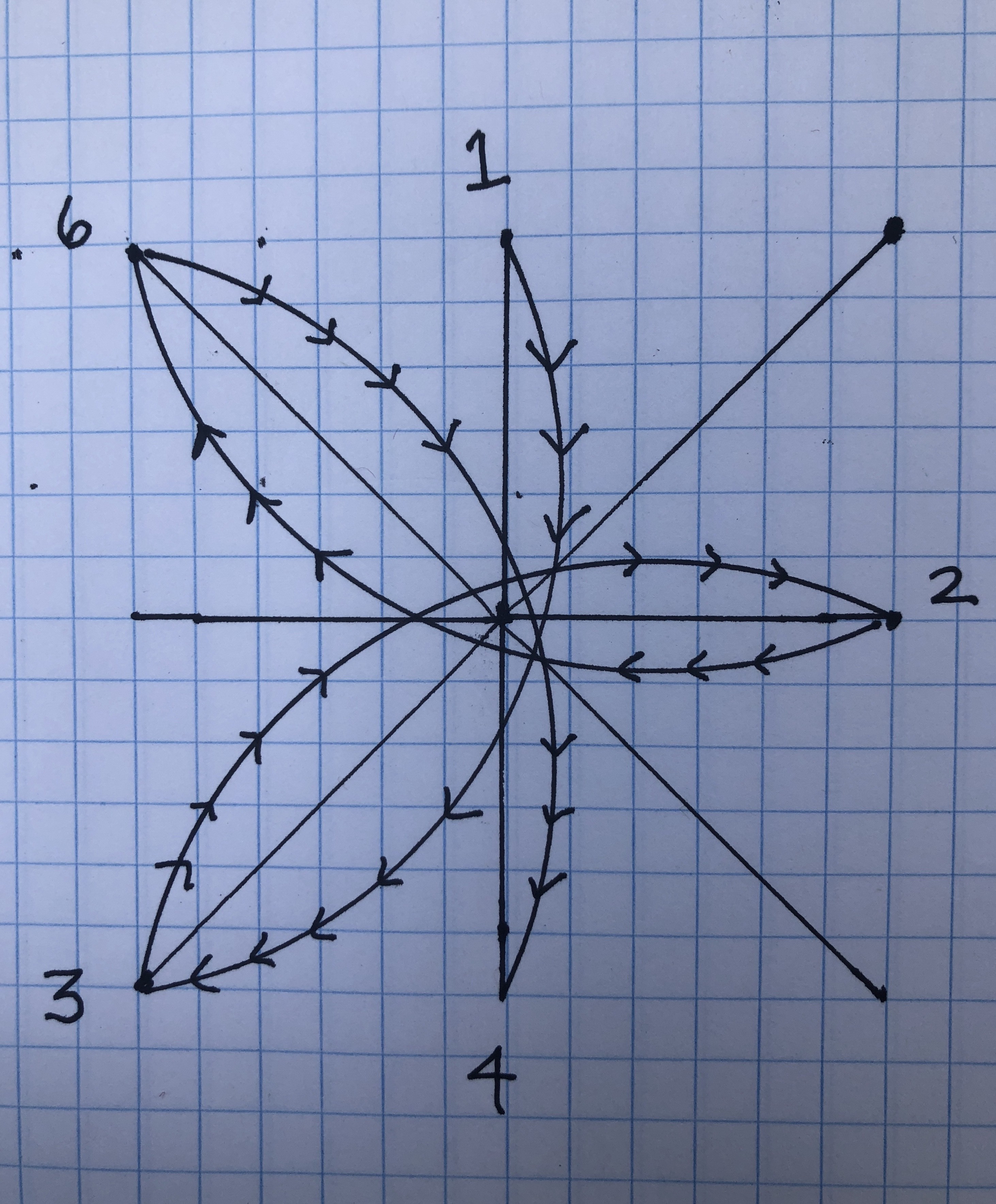
Now, add a curve back up to the upper right, the northeast, and draw a 9.
Proscribe a new curve over to the left mid-point, the west, and write in a 5.

Trace another curve down to the lower right, southeast, draw a 12.
Then it?s back up to the center top point, north, where you draw a 7.
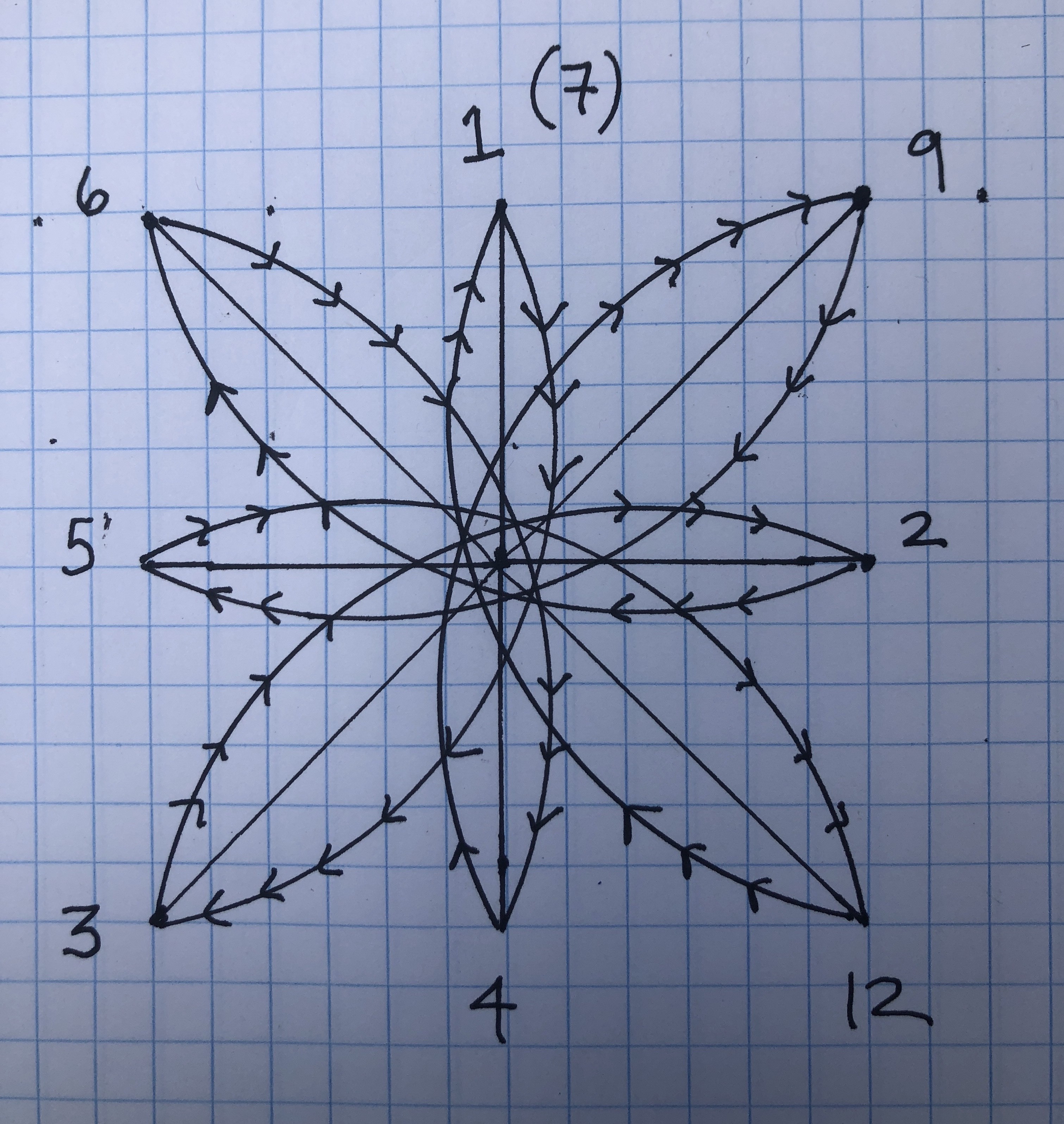
That?s one complete cycle. And the start of the next.
As you see, ultimately, the pattern describes a balanced 8-point star.
And used for dynamic math, this simple design records the difference between each new sum and the last sum, relative to a steady three-count of time. It?s that pendulum swing that revealed the pattern of prime numbers.
In many ways, this pendulum sequence is similar to the Fibonacci sequence, that is, if the Fibonacci sequence were tied to a steady three-count of time. This sequence acts more like math with a backbeat. It?s all about the difference between multiplying by twos, and multiplying by twos and threes at the same time.
When you divide by two, not only do you create two halves, but you also fall into this implied rhythm of 1 and 2, and 1, and 2, and 1, and 2. It?s like a march in music.
Whereas if you count: 1 and a 2, and a 1, and a 2, and a 1, and a 2. This ?and a-? adds an extra syllable. But it does more than that. It also adds a space in-between, which gives a swing to a beat. The ?and a-? is the key to swing. This pendulum sequence functions in a similar way, it utilizes a mathematical version of ?and a-? that adds a swing to multiplication. It?s like math being counted by a jazz drummer.
I think it helps to think of each one of the prime patterns as its own wave. As the waves rise and fall, they deviate, but then later the waves re-converge, they intersect, cross paths, only to diverge again, as they grow larger and larger as they roll forward along the continuum of numbers. Yet, always, this prime pattern stays as tight to a steady pendulum beat as Elvin Jones on the drum skins.
So there it is, the wave pattern of prime numbers. I don?t know what it means, but I thought you might find it interesting.
